MT Capital Research Report: DePIN reshapes the decentralized future of physical infrastructure
Author: Ian, Xinwei, Severin, MT Capital
TL;DR
1. DePIN Overview: The Decentralized Physical Infrastructure Network (DePIN) combines the physical world with Web3, reduces costs and improves efficiency through decentralized technology, and is widely used in computing, storage, wireless networks and other fields, from traditional fixed devices to new generation portable and wearable devices, with broad market prospects.
2. Investment trends and projects: DePIN projects have shown significant growth in both bull and bear market cycles, with project types covering wireless networks, maps, Internet of Vehicles, agriculture, drones, weather, energy, etc. Investment institutions have expanded from Europe and the United States to Asia, and the number of participating institutions and investments has continued to increase, showing a strong interest in the DePIN field.
3. Market demand and potential: There are many emerging DePIN markets, including health data, meteorology, energy, bandwidth,AIand mobile phones, etc., have huge market space and high growth rate. In particular, the energy and mobile phone markets have great potential, and health data andAIThe year-on-year growth rate of the market is also very impressive.
4. Project ecology andBlockchainChoice: Ethereum and Solana have become the main choice chains for existing DePIN projects and emerging DePIN projects respectively. Solana has high performance, low cost and strongCommunitySupport has attracted a large number of new projects and gradually become the preferred platform for DePIN projects. Representative projects such as Render, Helium, Hivemapper, etc. have demonstrated the diverse applications of DePIN. Core players such as Solana, IoTeX and other platforms have provided strong technical support and ecological environment for DePIN projects, promoting the rapid development of DePIN.
5. ModularityBlockchainTrend: Modular design significantly enhances the scalability and adaptability of DePIN. Through standardized interfaces and interchangeable components, DePIN can flexibly adapt to different application scenarios and technical requirements, thereby promoting rapid deployment and maintenance of the network.
6. TokenEconomic evolution: From the early fixed incentive model to the current dynamic incentive mechanism, DePIN projects such as Helium have ensured the continued growth and healthy development of the network by adjusting incentives for new and old equipment, regional incentive policies, and time period incentive adjustments.
DePIN Definition
DePIN, the full name of which is Decentralized Physical Infrastructure Network, literally means "decentralized physical infrastructure network". "De" stands for decentralized, "P" stands for physical, "I" stands for infrastructure, and "N" stands for network.
The core definition of DePIN is to bring real-world users into Web3 and achieve low cost and socialization through decentralized networks. In the current world, especially in the physical business field, DePIN achieves the goal of reducing costs and increasing efficiency through decentralized technology.
In previous studies and reports, DePIN often focused more on the infrastructure aspect, while this report (PDF full version, please go to the official website to download) focuses more on the decentralized part, trying to show the diverse DePIN markets and investment opportunities in the future.
DePIN Project Types
Classic DePIN equipment:
Characteristics: These devices are usually immobile and are usually fixed in place.
Main business: including computing, bandwidth and storage.
Market characteristics: The market of classic DePIN projects tends to be technology-oriented, especially in the fields of AI computing power, which are more sought after by funds and traffic. This type of market is large in scale, but the competition is fierce and it is a red ocean.
Representative projects: Filecoin, RNDR, etc.
New generation DePIN equipment:
Features: These devices are small and flexible and can be carried around or even worn.
Main business: Life-related services such as health monitoring, weather forecasts and mobile phone functions.
Market characteristics: The market of the new generation DePIN project is more inclined towards life, low-cost and suitable for daily applications. This type of market is diverse and has a wide range of applications. It has yet to be further explored and is a blue ocean with huge potential.
By comparing these two generations of DePIN projects, we can see that DePIN technology is constantly developing and its application scenarios are also expanding. From traditional fixed devices to today's more flexible and portable devices, the market prospects of DePIN are becoming more and more broad, covering various needs from high-tech fields to daily life. The traditional DePIN market is large in scale and is a fiercely competitive red ocean; while the innovative DePIN market has a wide variety of types and a wide range of applications, which has yet to be further explored and is a blue ocean with huge potential.
DePIN Investment New Ecosystem
In this bull market cycle, the number and types of DePIN projects have increased significantly. New generation lightweight DePIN projects have emerged frequently, adding wearable devices such as AI, bracelets, watches, etc. that collect health data, as well as a large number of portable lightweight physical device DePINs.
2022.1.1 – 2023.1.1
There are a total of 19 DePIN project financings, with the average disclosed financing amount being 18M. Excluding Helium's 200M large round of D financing, the average financing amount is 5.9M.
The project types include wireless networks, maps, connected vehicle data, agriculture, drone images, weather, electricity markets, and DePIN infrastructure, among which wireless networks have the largest number of projects, up to 7.
2023.1.1 – 2024.1.1
There are a total of 9 DePIN project financings, with an average disclosed financing amount of 7.2 M, which is significantly lower in number than in 2022 (bear market), and the amount has increased by 22% compared to 2022.
Project types include wireless networks, decentralized computing power, maps/geospatial data, weather, DePIN infrastructure, and the number and types of financing have decreased significantly. (The bear market requires more reasonable business scenarios and models)
2024.1.1 – 2024.5.20
There are 26 DePIN project financings in total, with the average disclosed financing amount being 6.5M. The number of financings has increased significantly, while the financing amount has decreased.
Project categories include decentralized computing power, Internet of Vehicles, Internet of Things, wireless networks, FHE, maps, weather & environment, bandwidth, DePIN infrastructure, mobile phones, energy, storage, mixed reality
New first-level financing types that have not been disclosed: AI, VPN, bracelets/watches and other wearable and portable device projects (health data)
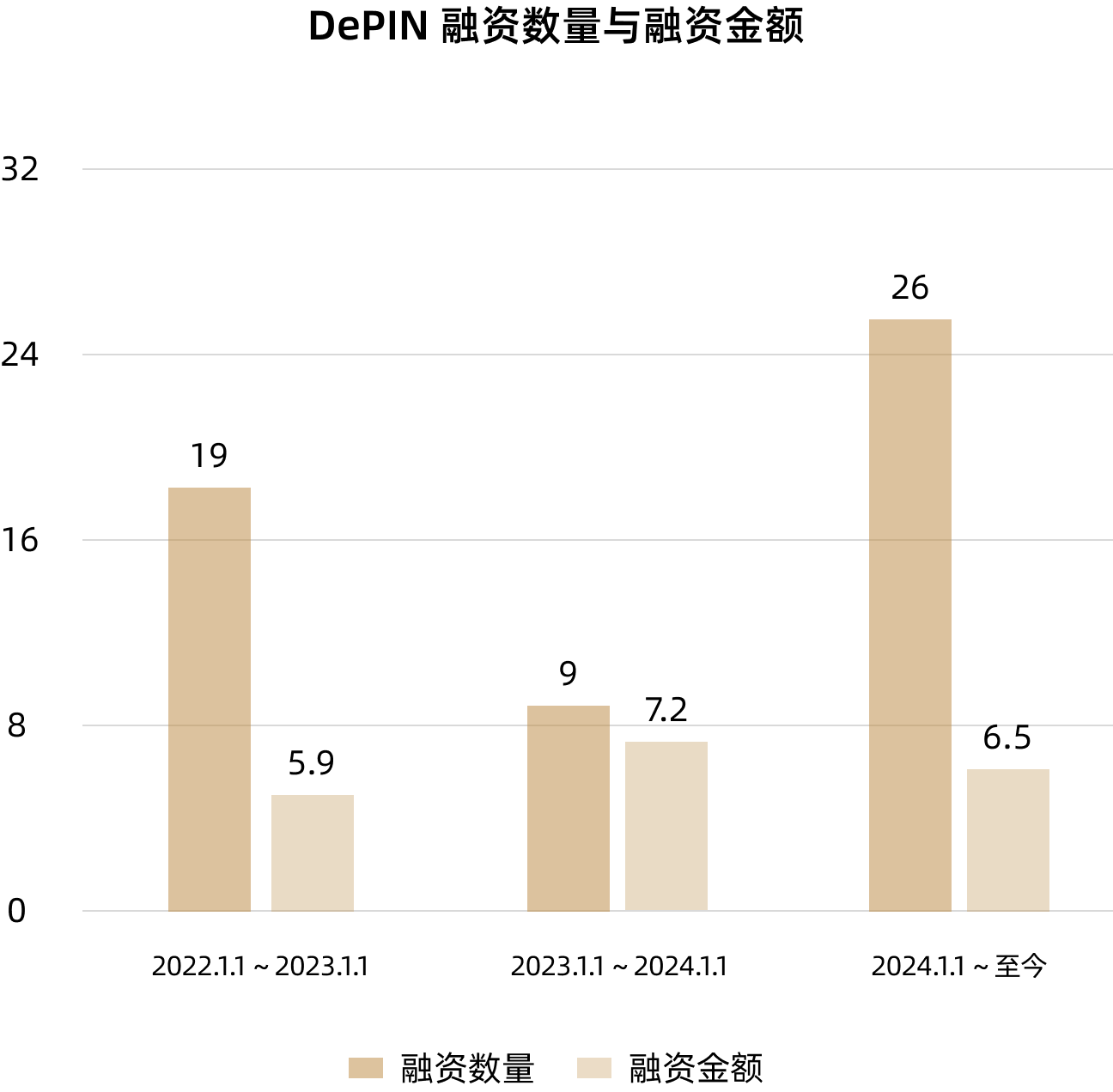
source:MT Capital
Number of DePIN projects and institutions
In the previous cycle, the participating institutions of DePIN were mainly from Europe and the United States. In this cycle, more Asian institutions have gradually emerged, showing their strong interest in DePIN. The number of DePIN projects has also increased significantly, with more than 135 second-level DePIN projects and more than 130 first-level DePIN projects.
project:
• Secondary market projects: 137
•>$1B FDV: 20 pcs
•$500M – $1B: 19 pcs
•$100M – $500M: 48 pcs
•$50M – $100M: 16 pcs
•$30M – $50M: 14 pcs
•$10M – $30M: 12 pcs
•
•Primary market projects: 133
•Since the start of the current bull cycle (from October 2023 to present), a total of 8 projects have raised more than $2 million in funding and 6 projects have raised more than $10 million in funding.
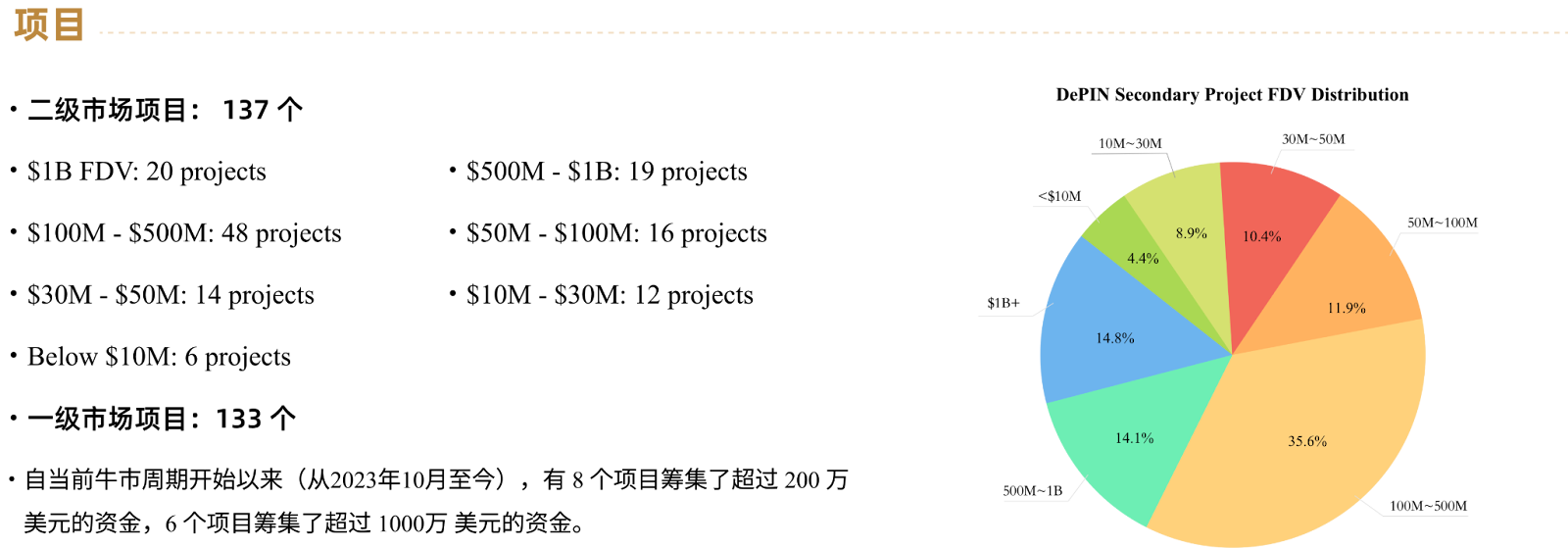
source:MT Capital
mechanism:
Last cycle:
•Andreessen Horowitz (A16z)
•Multicoin Capital
•HashKey Capital
•IOSG Ventures
•Spartan Group
•Borderless Capital
•Lattice Ventures
•Variant Fund
•Delphi Digital
•Big Brain Holdings
•Cogitent Ventures
This cycle:
•OKX
•Animoca Brands
•JDI
•IoTeX
•FMG
•Waterdrip Capital
•MH
DePIN Market Demand
In the last cycle, new projects continue to emerge in the DePIN sub-track represented by computing power, storage, wireless networks and maps. This cycle has added new sub-track categories such as wearable devices, meteorology, energy, bandwidth, AI and mobile phones based on health data.
From the perspective of market demand, the energy market and the mobile phone market have huge market space. The health data market and the AI market not only have a large market space, but also have a very high year-on-year growth rate. The market size is very objective.
Market: (number of projects in the primary market + number of projects in the secondary market)
Health (5+/), Weather (9+1), Energy (15+10), Computing Power (17+29), Storage (7+19), Wireless Network (9+11), Bandwidth (6+4), Maps (3+2), AI (8+13), Mobile Phones (5+)
Number of market projects in the last cycle
•Hashrate: 17+29
•Storage: 7+19
•Wireless network: 9+11
• Map: 3+2
Number of projects in emerging markets
• Health data (wearable devices): 5+ /
•Weather: 9+1
•Energy: 15+10
•Bandwidth: 6+4
•Mobile: 5+
•AI: 8+13
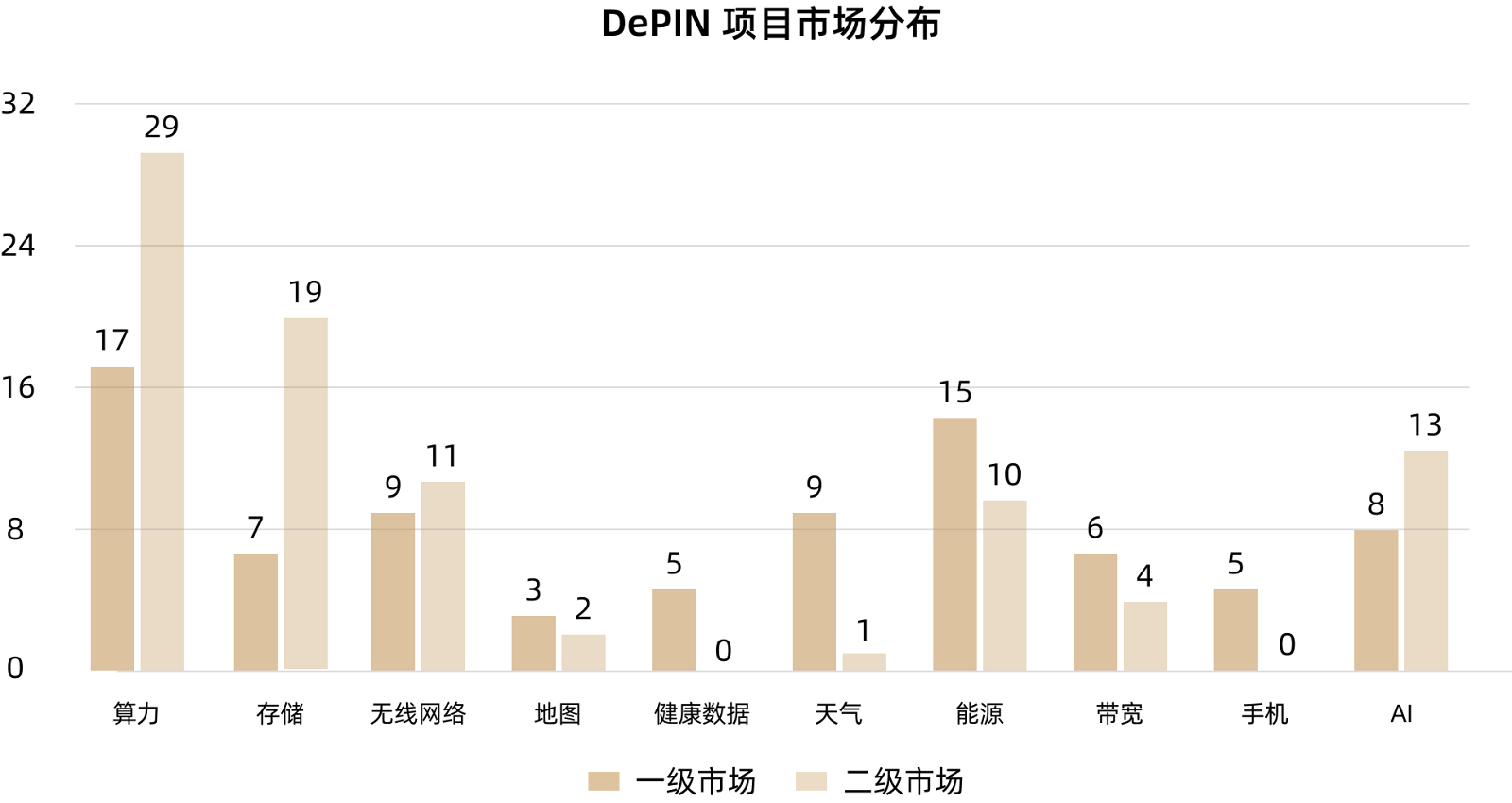
source:MT Capital
Market size and growth rate
•Health market: $243B, CAGR 17%
• Weather market: $7B, CAGR 7%
•Energy market: $880B, CAGR 8.4%
•Hashrate market: $95.7B, CAGR 6.8%
• Storage market: $108B, CAGR 22%
• Wireless Network Market: $500B, CAGR 12%
•Bandwidth market: $8.6B, CAGR 13.75%
• Map market: $19B, CAGR 12.5%
•AI market: $150B, CAGR 36.8%
•Mobile phone market: $484B, CAGR 7.3%

source:MT Capital
Public chain selection and device type

source:MT Capital
Currently, the largest number of DePIN projects in the secondary market are based on the Ethereum chain, with a total of 70 DePIN projects choosing to be built on Ethereum, accounting for a total of 81%.
Among the collected primary projects, there are 28 Solana ecological projects, accounting for 62% in total. Solana is gradually becoming the first public chain of the new round of DePIN projects.

source:MT Capital
From the perspective of device types, there are more new energy and sensor device projects. And more projects with wearable, portable, and home device as physical hardware are beginning to emerge in the primary market.
DePIN Full Industry Chain
Upstream supply chain
1. Hardware manufacturing and supply
Hardware suppliers: produce various devices and sensors for DePIN network, such as GPU, server, IoT device, wireless device, etc. For example, LoRaWAN hotspot for Helium network, dashcam for Hivemapper.
Professional hardware manufacturers: Some professional hardware manufacturers provide customized hardware for specific DePIN projects, such as storage miners for Filecoin and GPUs for Render network.
2. Chips and Semiconductors
Chip manufacturers: such as NVIDIA and AMD, provide high-performance GPUs for computing networks such as Render and Akash. These chips are at the heart of processing AI workloads and complex computing tasks.
3. IoT devices
Sensor manufacturers: Provide sensor devices required for environmental monitoring, traffic data collection, etc. For example, Bluetooth sensors in the Nodle network and noise pollution detectors from Silencio.
Smart devices: such as smartphones and other mobile devices, which can act as part of a sensor network for data collection and transmission.
4. Power and energy equipment
Energy equipment suppliers: Provide solar panels, wind turbines, energy storage batteries and other equipment for decentralized energy networks, such as solar panels and battery systems in the Daylight Energy network.
Midstream Industry Chain
1. Network operation and maintenance
Network operators: such as Helium and Hivemapper, manage and maintain the normal operation of decentralized networks, including node management, data transmission and storage.
Service provider: Provides network infrastructure services, such as cloud computing services, storage services, etc.
2. Software and platform development
Blockchain平台:如Solana和IoTeX,为DePIN项目提供基础Blockchain技术支持,包括智能contractExecution, data storage, and validation.
Software developers: Develop software platforms and tools for managing and operating the DePIN network, such as the distributed storage management platform provided by Filebase and the video streaming management tool provided by Livepeer Studio.
3. Data Processing and Analysis
Data analytics companies: Process and analyze data collected from sensor networks to provide valuable insights and services to users.
AI and machine learning services: such as Beam, which provides cloud-based AI computing services and distributes model training and inference workloads to a decentralized GPU network.
Downstream industry chain
1. Applications and Services
Enterprise customers: Use the services provided by the DePIN network to enhance their business efficiency, such as logistics companies using Hivemapper's map data and agricultural companies using Geodnet's high-precision positioning data.
Consumer applications: such as Teleport's shared travel application and DIMO's vehicle data platform, which provide consumers with convenient services and earn rewards through user-contributed data.
Smart cities and public infrastructure: Using data and services from decentralized networks to optimize urban management and public services such as energy management, traffic management, etc.
Modularity/Data Layer/Middle Layer
Modular blockchain optimizes blockchain scalability by separating core functions such as execution, consensus, data availability, and settlement into different layers.SafetyFor example, Ethereum improves data availability and processing power by adopting sharding architecture and rollup, while Cosmos achieves cross-chain interoperability and high customization through IBC protocol and Tendermint consensus mechanism. The advantages of modular blockchain include higher transaction processing capacity, enhancedSafetyThe increased flexibility and development potential of blockchain technology will further promote the development of blockchain technology in the future.
DePIN's modular trend significantly enhances its scalability. The modular design enables DePIN to flexibly adapt to different application scenarios and technical requirements, simplifying the deployment and maintenance of the network through standardized interfaces and interchangeable components. For example, the Render network has achieved expansion from image rendering to AI model training through a modular structure, increasing the network's service scope and market potential. In addition, Filecoin's modular design allows it to expand storage services, add hot storage and data computing functions, further enhancing the practicality and attractiveness of its network. The modular trend not only improves the technical compatibility and upgrade capabilities of the DePIN network, but also enables each independent module to develop and optimize independently, thereby accelerating the innovation and progress of the entire network ecosystem. This flexible and efficient architecture greatly improves the scalability of DePIN, enabling it to respond to market demands and technological changes more quickly, and promote the widespread application and development of decentralized infrastructure.
Representative Projects
DePHY
DePHY is a development framework designed specifically for DePIN. Through key functions such as the message layer, DID (Device ID), open source hardware design, off-chain computing network and re-mortgage layer, it significantly reduces development costs and time, supports any standard interface hardware, and achieves fast, efficient,SafetyDecentralized infrastructure project deployment.
PINGPONG
PINGPONG is a DePIN liquidity and service aggregator that optimizes and maximizes mining returns across multiple networks through innovative tools and solutions.
DePIN track platform and players
Solana
Solana is becoming the new super infrastructure of DePIN. Solana's high performance, low network fees, powerful developers and usersCommunityAnd high purchasing power makes it the preferred launch network for many DePIN projects. Some old DePIN star projects such as Render and Helium have achieved better development after migrating to Solana, which shows the vitality that Solana's strong infrastructure and broad community user base bring to DePIN projects. Solana has gradually attracted emerging and cutting-edge DePIN projects of different categories including Grass, Natix, Exabits, etc., and is gradually improving its own DePIN ecosystem.
Representative Projects
Render
Render Network is a decentralized GPU rendering platform that leverages blockchain technology to connect artists with GPU providers for scalable, cost-effective rendering solutions.
Hivemapper
Hivemapper is a decentralized mapping network that uses blockchain technology and crowdsourced dashcam data to create detailed real-time maps.
Helium
Helium is a groundbreaking DePIN project that creates a decentralized wireless network that allows IoT devices to connect globally through a distributed network of hotspots.
Natix:
Natix Network is a blockchain-based crowdsourced camera network for creating a real-time world map.
Exabits:
Exabits is a decentralized infrastructure for artificial intelligence and compute-intensive applications. It allows users to provide distributed GPU services, data storage, or expertise to the AI community without the need for a central authority or intermediary.
Grass:
Grass is a DePIN project developed by Wynd Network that allows users to monetize their unused network resources by adding their connected devices to a decentralized network designed to provide data for AI training.
EV3
EV3 is a philosophy-driven investment firm that supports outstanding entrepreneurs building DePIN. By investing up to $1 million in early-stage projects, EV3 aims to unlock the next $100 trillion of global GDP through next-generation open infrastructure networks such as telecommunications, logistics, energy, cloud computing and artificial intelligence. Founded by institutionally trained investors Mahesh Ramakrishnan and Salvador Gala, EV3 combines deep industry expertise and long-term partnerships with the support of leading investors.
Representative Projects
3DOS
3DOS is the world's largest decentralized on-demand manufacturing network, aiming to revolutionize the manufacturing industry through blockchain technology and 3D printing. The platform allows anyone to upload designs, receive royalties, and manufacture on demand around the world.
Zonal
Zonal is developing a decentralized network based on a micro-positioning protocol that uses wireless communication technologies such as ultra-wideband (UWB) and low-power Bluetooth (BLE) to provide highly reliable global and indoor positioning services to verify real-world interactions. Its goal is to create a unified protocol that provides location verification tools for various services and enterprises.
XNET
XNET is a next-generation mobile operator that uses blockchain technology to build a decentralized network. By using the CBRS spectrum, XNET aims to build a reliable industry-grade neutral host network. The project aims to solve the inefficiency and capital intensity of the telecommunications industry through its distributed radio access network (RAN).
IoTeX
IoTeX is an open platform with modular AI+DePIN infrastructure, which aims to connect smart devices and real-world data to Web3, allowing Web2 to easily and effectively access blockchain and create a decentralized real-world open ecosystem of multi-dimensional data and scenarios. Through modular construction, developers can connect smart wearables, Internet of Vehicles, green energy, environmental data and other full-scenario innovative applications from smart life to smart industry in Web3.
As of the first quarter of 2024, the IoTeX network has 108 active nodes with a total staked value of $29 million, a month-on-month increase of 73%. The average stake participation rate reached a record high of 40.6%. In addition, node rewards increased by 71% month-on-month to $3.3 million.
IoTeX provides complete "plug-and-play" products and tools that enable blockchain-driven IoT applications to be efficiently built and deployed. The platform is divided into four layers: hardware layer, middleware layer, tool layer, and blockchain layer. Since its establishment, IoTeX has raised more than US$90 million in funding to support its R&D and market expansion. IoTeX's solutions support various IoT ecosystems, such as the sharing economy, smart home, autonomous driving, and supply chain management.
Representative Projects
Network3
The Network3 project is a Layer2 blockchain platform that integrates AIoT technology. It aims to provide AI developers with efficient model training and verification tools, while enabling users to earncryptocurrency.
Inferix
Inferix is a decentralized GPU visual computing platform dedicated to 3D/AR/VR rendering and AI inference.
Wayru
Wayru Network is a decentralized wireless network that implements various intelligent functions through WayruOS and Wayru Connectivity Superapp.
DePIN segmentation based on physical hardware devices
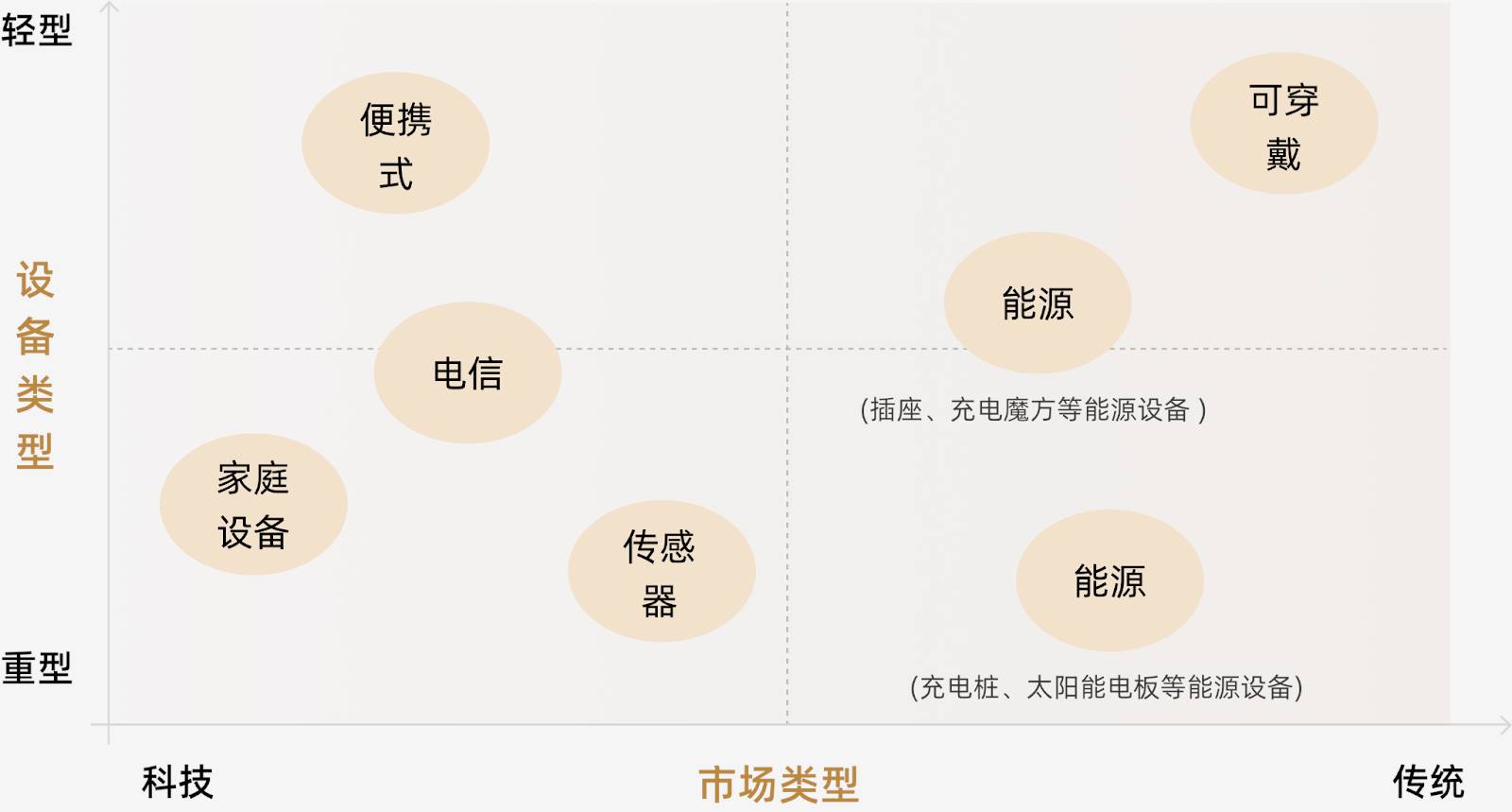
source:MT Capital
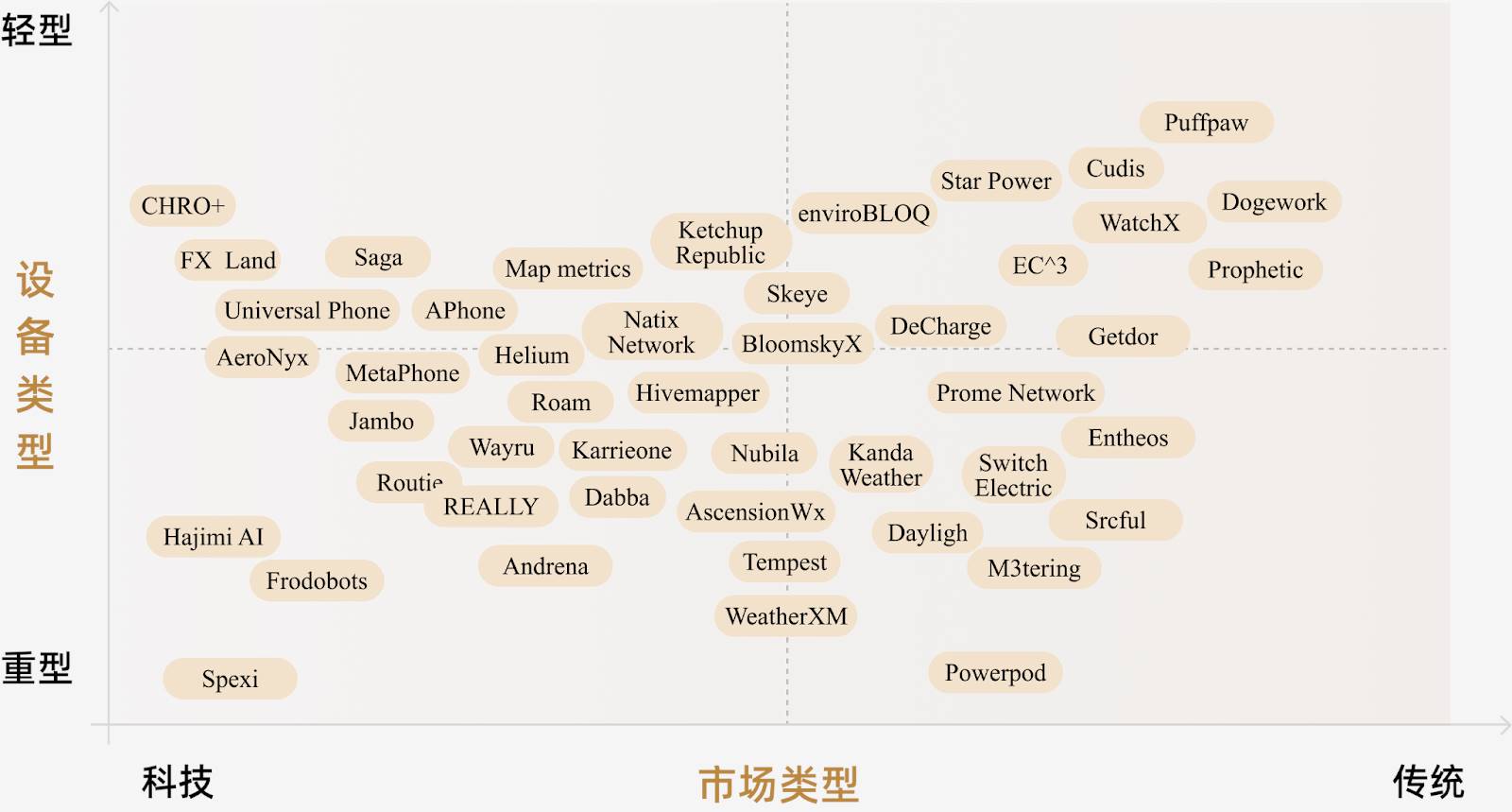
source:MT Capital
Track Mapping
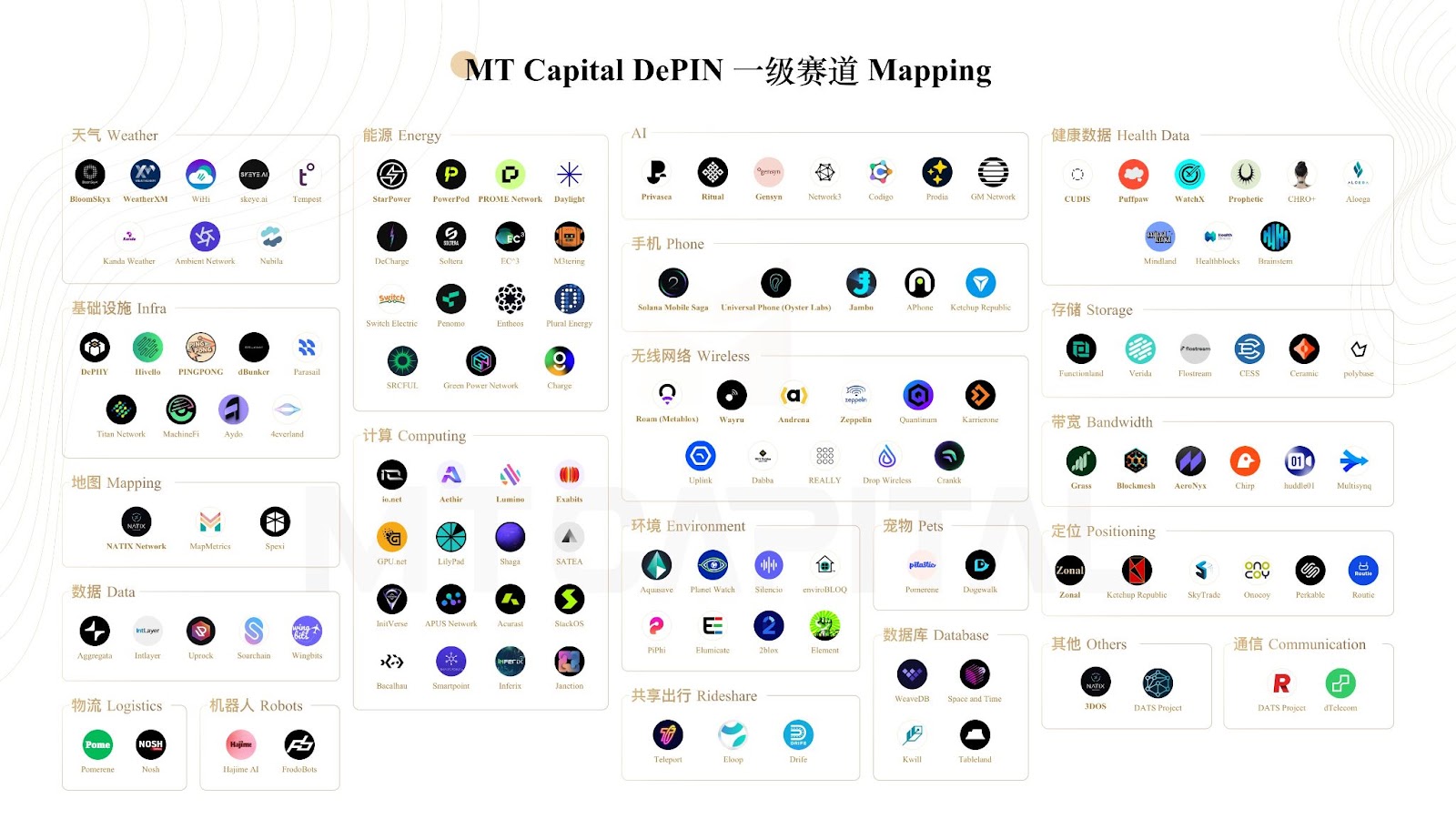
Sensor Track
我们将“传感器”定义为室外传感器,它可以帮助用户收集各种类型的数据,如地图、天气和车辆信息。这些室外传感器收集数据后,用户可以贡献他们的数据以创建数据价值网络,并获得相应的代币奖励。DePIN 项目可以聚合这些用户共享的数据,为 B 端客户提供更加多样化的数据样本,并捕获来自 Web2 的商业收入。
Representative Projects
Map Network
Hivemapper
Hivemapper is a decentralized mapping network that uses blockchain technology and crowdsourced dashcam data to create detailed real-time maps.
Internet of Vehicles Data Network
DIMO
DIMO is a decentralized IoT vehicle data DePIN network that enables vehicle owners to collect, use and monetize data from their vehicles.
Positioning Network
Geodnet
GEODNET is a blockchain-based global earth observation decentralized network that uses real-time kinematic technology (RTK) to significantly improve GPS accuracy.
Wireless Network Track
Mobile wireless network:
-
Market size and growth: In 2022, it will account for more than 76% of market share in the telecommunications industry, and this growth is mainly driven by 5G and IoT technologies. It is expected to grow at a compound annual growth rate of 6.2% from 2023 to 2030.
-
Function: Provides extensive personal and business connections through cellular technology. Supports a variety of devices and applications to achieve mobile communications and data services.
-
Future Outlook: The demand for mobile wireless networks will continue to increase due to the increasing demand for higher bandwidth, advancements in 5G technology, and the integration of IoT devices.
Helium
Helium is a groundbreaking DePIN project that creates a decentralized wireless network that allows IoT devices to connect globally through a distributed network of hotspots.
Fixed Wireless Access (FWA):
-
Market size and growth: As an alternative to wired broadband, especially in areas where laying cables is not practical, it is growing rapidly. The market size is expected to grow from 130 million connections at the end of 2023 to 330 million in 2029.
-
Function: Use radio waves to provide Internet services between fixed points. Usually deployed in areas where mobile wireless network services are insufficient. Compared with wireless mobile networks, it has lower laying costs and is easier to deploy.
-
Future Outlook: Thanks to the improvement of 5G technology, FWA is expected to become a more common form of Internet access, especially in remote areas and rural areas where infrastructure services are insufficient.
Andrena
Andrena is a high-speed fixed wireless access network service provider that uses cutting-edge radio technology to create high-speed, low-cost wireless networks in cities and areas underserved by mobile wireless networks.
Wi-Fi Network:
-
Market size and growth: The market value is approximately US$14.5 billion in 2023 and is expected to reach US$39.4 billion by 2028, with a compound annual growth rate of 22.2%.
-
Function: Provides local area network connections for devices through radio waves, supporting a wide range of consumer electronics from smartphones to home appliances, and can be used in limited private spaces such as homes, businesses, and public hotspots.
-
Future Outlook: Market growth will be driven by the increasing demand for reliable internet connectivity for smart devices and the growing implementation of IoT in the public and private sectors.
Roam
Roam is a decentralized global WiFi network that provides enterprise-grade OpenRoaming WiFi roaming services to the public around the world.
Energy Track
Traditional energy markets face the following problems: mismatch between supply and demand in regional energy networks, lack of transparent and tradable energy markets, large untapped clean energy markets, slow and costly expansion of energy networks… However, DePIN can help shape a new generation of decentralized energy networks.
From a market perspective: The clean energy market is experiencing significant growth, with a market value of approximately $1.4 trillion currently, and a CAGR of 9.1% expected from 2022 to 2032. The renewable energy market is expected to grow from a market size of $881.7 billion to approximately $1.9 trillion in 2030, with a CAGR of approximately 8.4%. Energy DePIN projects have a huge market space.
Power Plant:
StarPower
Starpower is a groundbreaking DePIN project that aims to revolutionize energy management and distribution by creating a virtual power plant (VPP) through a decentralized network leveraging blockchain technology.
Energy Trading
Daylight
Daylight is an open source blockchain network focused on creating a decentralized marketplace for renewable energy and carbon credits, aiming to promote more sustainable energy trading and use around the world.
Energy Storage
PowerPod
Powerpod aims to revolutionize the way electric vehicles (EVs) are charged by creating a shared, blockchain-powered network of community-owned charging stations.
Home Equipment Track
家庭设备领域专注于利用去中心化技术提升和优化日常生活的各个方面。该领域解决了高成本、隐私问题和资源分配不均等关键问题,通过将标准家庭设备转变为去中心化网络节点来提供解决方案。通过使用区块链和其他去中心化协议,这些设备为传统云服务和计算能力提供了低成本、Safety且高效的替代方案。这种方法不仅减少了对集中式基础设施的依赖,还赋予用户更大的数据和资源控制权。此外,这些设备的集成不仅增强了智能家居生态系统和游戏体验,还旨在提升日常互动,创造一个全球互联的社区。
FX land
FX Land provides a distributed cloud storage solution that solves high storage costs and privacy issues through Crowd Storage nodes and the Fula protocol.
Hajime AI
The Hajime AI project aims to create a global edge computing power supply network to provide cost-effective computing services to AI startups, solve the problem of uneven distribution of computing resources through a decentralized platform, and seamlessly integrate with smart home and IoT ecosystems in the future.
FrodoBots
The FrodoBots project uses real-world robots in a gamified way to solve the problem of embodied AI.
Wearable device track
In the field of wearable devices, the focus is on combining smart wearable devices with blockchain technology. They use advanced artificial intelligence and data privacy protection technologies to provide personalized health monitoring and data management services. By enabling users to monetize their own data and providing reward mechanisms, these devices motivate users to actively participate in health management. These devices are usually made of high-quality materials, have long battery life and strong waterproof capabilities to ensure user convenience and safety. In addition, these smart wearable devices are compatible with mainstream mobile devices andcryptocurrencyEcosystem, while improving user health and quality of life, it promotes the widespread adoption of decentralized applications and the Web3 ecosystem.
CUDIS
CUDIS is a stylish, groundbreaking AI smart ring that motivates users by rewarding them on their health journey. It has core features such as immutable data collection and control, personalized AI coaching, health motivation tasks and social activities.
WatchX
The WatchX project aims to integrate millions of smartwatch users into the Web3 ecosystem and provide a wide range of opportunities for partners within the ecosystem space.
Dogewalk
A DePIN platform that integrates innovative software and hardware through GameFi and SocialFi elements to enhance the interaction between pet owners and Web3 users.
Portable Devices Track
Portable projects share common characteristics, such as providing convenient mobile devices and applications to enhance the Web3 experience. They focus on simplifying user interactions, improving security, and implementing data ownership and reward mechanisms. These projects integrate hardware and software solutions to promote the development and use of decentralized applications, especially in mobile environments. The goal of this segment is to promote the adoption and application of Web3 technologies by lowering barriers to entry, optimizing user experience, and providing practical application cases.
Solana Mobile Saga
The Solana Mobile Saga project aims to lead the Web3 mobile revolution by providing top-tier hardware and powerful developer resources, delivering a secure and user-friendly decentralized application experience.
Universal Phone Oyster Labs
The Universal Phone project was launched by Oyster Labs, aiming to reach 800 million Telegram users, focusing on emerging markets such as India, Indonesia and Nigeria.
Puffpaw
Puffpaw is aDAO The "Quit Smoking and Earn" project incubated by the company helps users quit smoking and get financial rewards through electronic cigarette devices and blockchain technology.
Token economy of the DePIN project: fixed incentive model evolves into dynamic incentive
Internal logic analysis: Taking Helium as an example
Early incentive mechanisms and their impact
In the early days of the Helium project, early participants were able to obtain very high token rewards by purchasing and deploying mining machines. This high return attracted a large number of early users and quickly promoted the expansion of the network. However, this incentive mechanism also brought some problems:
Early participants profited too much: Early users quickly realized high returns due to the large number of tokens they received. Although this phenomenon promoted the rapid growth of the network in the early stage, it also led to a rapid increase in the supply of tokens in the market.
Token economic fluctuation adjustment: Due to the large number of tokens in the hands of early participants, they began to sell tokens on the market, causing token prices to fluctuate and fall. When new users enter the market, they find that the rate of return is much lower than that of early users, resulting in a slowdown in the growth of new users.
Stagnation of network growth: As the early high returns gradually disappear, the willingness of new users to enter decreases, the expansion of the network slows down, and the growth of the project slows down.
Introduction of dynamic incentive mechanism
To address the above issues, the Helium project introduced a dynamic incentive mechanism to ensure the continued growth and healthy development of the network.
Adjust incentives for new and old devices: Helium adjusts the incentive mechanism for new and old devices so that users of new devices can also receive attractive rewards. For example, the initial reward for new devices is increased, and while maintaining a robust network, the reward ratio for outdated devices is gradually reduced to encourage users to purchase and deploy new devices.
Regional incentive policies: In order to promote the balanced development of the network worldwide, Helium has formulated differentiated incentive policies based on the equipment deployment in different regions. In areas with fewer devices, higher token rewards are provided to attract users to deploy equipment in these areas.
Time period incentive adjustment: Helium balances network load and improves equipment utilization by providing different rewards at different time periods. For example, users who run equipment during off-peak hours can receive additional rewards, thus ensuring the stable operation of the network around the clock.
Device density incentives: In areas with low device density, Helium provides additional incentives to promote stable operation of devices and efficient data transmission. This not only increases user benefits, but also improves the overall performance of the network.
Specific implementation of dynamic incentives
The Helium project uses smart contracts and algorithms to implement dynamic incentive mechanisms to ensure real-time adjustment and fair distribution of incentives. These measures not only increase the participation enthusiasm of new users, but also stabilize market expectations and prevent market fluctuations caused by early high returns.
Smart contract incentive adjustment: Through smart contracts, rewards for different devices are dynamically adjusted according to device usage and market demand. This mechanism ensures the flexibility and real-time nature of incentives.
Real-time data feedback: By collecting and analyzing the operating data of the equipment, the Helium project can timely adjust the incentives for different areas and time periods to ensure the optimal configuration and utilization of network resources.
Transparent incentive mechanism: The transparency and openness of the dynamic incentive mechanism enhances user trust and encourages more users to participate in network construction.
Changes in incentives for new and old equipment
New device incentives: In order to lower the user entry barrier, new devices usually have higher initial incentives to attract early adopters. Projects may incentivize users to purchase and deploy new devices through high token rewards and low initial costs, making it easier for new users to participate.
Incentives for old equipment maintenance: To prevent users from abandoning old equipment, the project will provide continuous incentives, but these incentives may gradually decrease over time. Through equipment upgrade rewards and maintenance fee subsidies, the project can adjust the operating costs of old equipment to ensure its continued effective operation.
Physical market changes
Equipment price adjustment: According to market demand and the service life of the equipment, the project party will adjust the price of different types of equipment. Due to capacity, supply and orders, the cost of new equipment is usually higher, but its incentive is also higher. The price of old equipment is lower, but it can still obtain stable income, thus attracting users at different levels.
Secondary market transactions: The equipment can be traded on the secondary market. The project owner can collect transaction fees and use part of the proceeds to repurchase and destroy tokens to support the token price. This method not only increases the liquidity of the equipment, but also stabilizes the value of the token.
Different regional markets
Regional incentive policies: In order to promote balanced deployment of equipment around the world, the project party will formulate differentiated incentive policies based on the market demand and development of different regions. For example, in areas with low equipment density, higher rewards may be provided to attract more equipment deployment, thereby achieving global coverage of the network.
Localized support: The project party will provide localized technical support and training in different regions to help users better install and maintain equipment, improve equipment operating efficiency and user participation enthusiasm. This localized support can effectively promote the promotion and development of the project in various regions.
Equipment density
Density Rewards: In areas with lower device density, the project may provide additional rewards to enable lower density areas to achieve growth, in order to promote stable operation of devices and efficient data transmission. These rewards may include higher token incentives and device upgrade subsidies to encourage users to keep their devices in good working order.
Dynamic adjustment: The project owner can adjust the equipment density in different areas according to real-time data.Xiaobai NavigationDynamic adjustments are made to ensure balanced development of the network and optimal allocation of resources. Through such dynamic adjustments, project owners can flexibly respond to market changes and optimize network performance.
Equipment operation time period
Time period rewards: In order to balance the network load and improve equipment utilization, the project party can set different rewards in different time periods. For example, devices running during non-peak hours can receive additional incentives to ensure the stable operation of the network around the clock.
Load balancing mechanism: Project owners can dynamically adjust incentives for different time periods through smart contracts and algorithms to achieve balanced distribution of network load and optimal utilization of resources. Through this mechanism, project owners can effectively manage network resources and improve overall operational efficiency.
Summary and Outlook
We believe that in the DePIN track, both classic DePIN and new generation DePIN have sufficient categories and a broad market, and have the potential to produce great projects with large-scale user adoption. In the future, it is very likely that a Web3 project will be born in this field and enter the top 20.
The core logic of DePIN lies in the cost reduction and efficiency improvement of existing world businesses by WEB3. By bringing real-world users into Web3, DePIN not only achieves low cost and socialization, but also greatly increases the number and accuracy of data sources. In the three generations of DePIN devices, from fixed devices to flexible and portable devices, the market prospects are constantly expanding, covering various needs of high technology and daily life.
In recent years, the types and number of investments in the DePIN market have increased significantly, and the number of institutions and projects has continued to grow. From the demand side, DePIN has shown great potential in multiple markets (such as weather, air quality, health, AI, etc.) and device types (such as wearable devices, mobile phones, etc.). The upstream and downstream industrial chains are also gradually improving, including on-chain interactive data, device middle layer, data and hardware.
It is particularly noteworthy that the life cycle of DePIN is theoretically longer than that of non-DePIN projects due to the combination of physical equipment and token design. This makes the DePIN track have huge potential and deserves investors' high attention and investment.
Looking ahead, with the development of the DePIN project and the advancement of technology, we have reason to believe that more innovative and influential projects will emerge in this field, injecting new vitality and possibilities into the Web3 ecosystem.
Thanks for your support:
Salvador @DAnconia_Crypto from EV3
Anna @gizmothegizzer from Solana
Raullen@raullen from IoTeX
Peter from Hashkey
EO @ Future money group
Reference:
–https://messari.io/report/state-of-depin-2023
–https://messari.io/report/infrastructure-sector-brief-gpu-networks
–https://messari.io/report/navigating-the-depin-domain
–https://messari.io/report/the-depin-sector-map
–https://public.bnbstatic.com/static/files/research/depin-an-emerging-narrative.pdf
–https://htxresearch.medium.com/depin-current-state-and-prospects-ad6b1a59b3d4
–https://foresightnews.pro/article/detail/50839
–https://twitter.com/rsarrow/status/1778471355425386928?s=46
MT Capital
MT Capital is a global investment institution managed by a team of senior investors, focusing on investing in innovative Web3 projects around the world, covering the United States, Hong Kong, Dubai and Singapore. Our main investment areas include: 1) Mass adoption: decentralized social platforms, games, applications and DEPIN, which are the key to promoting the spread of Web3 technology to a wide range of user groups; 2) Crypto native infrastructure: We focus on investing in public chains, protocols and other infrastructure that support and strengthen the ecosystem, as well as native DeFi solutions. In addition, our team also has many years of professional experience in secondary trading.
Official website:https://mt.capital/
Twitter:https://twitter.com/mtcap_crypto
Medium:https://medium.com/@MTCapital_US
The article comes from the Internet:MT Capital Research Report: DePIN reshapes the decentralized future of physical infrastructure
Related recommendations: 5 trading rules for MEME coins: follow the trend and stop profit in time
Memes are high-risk investments; when someone wins, someone else loses. Written by: Xremlin Translated by: Xiaobai Navigation Coderworld During this period, many meme traders have made huge fortunes. Buy $100 7 days after $WIF is released, now it is $1,800,000. Buy $100 7 days after $BODEN is released…